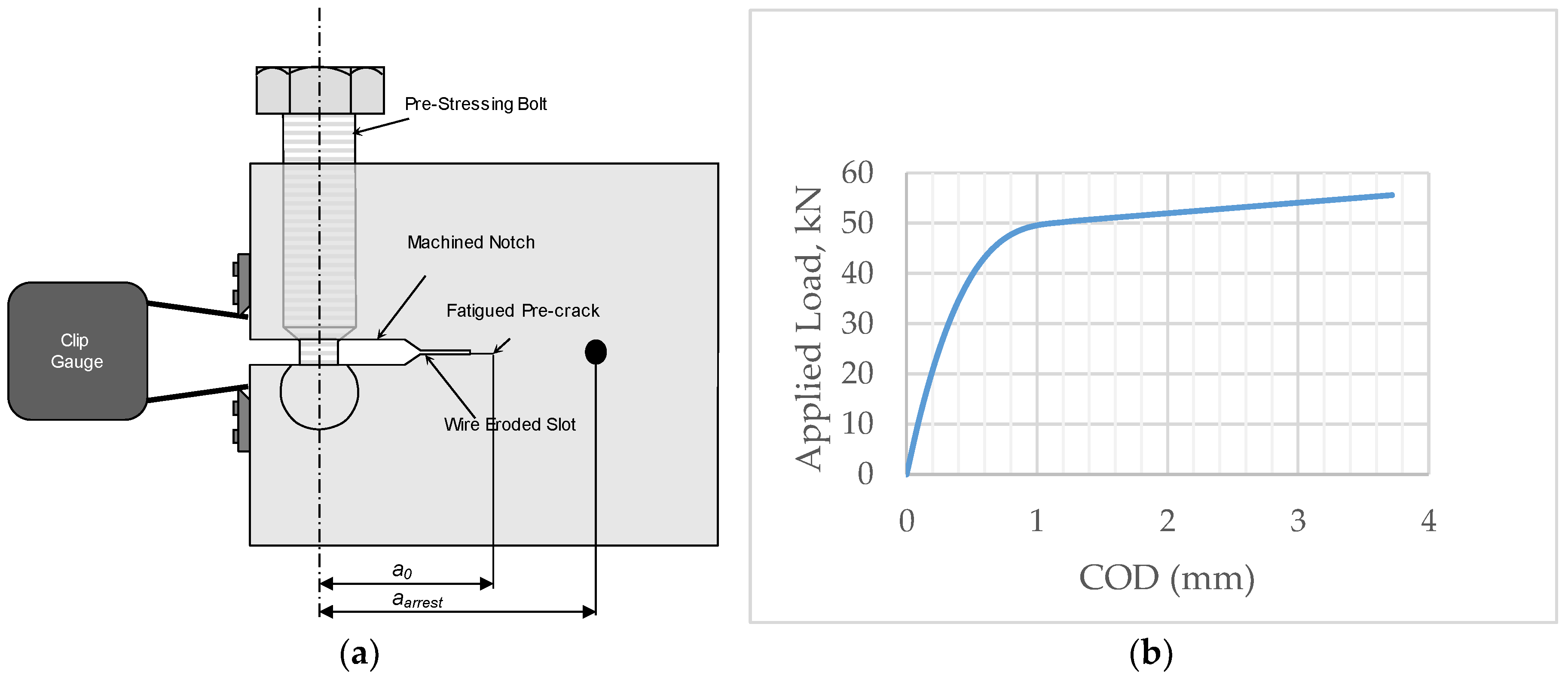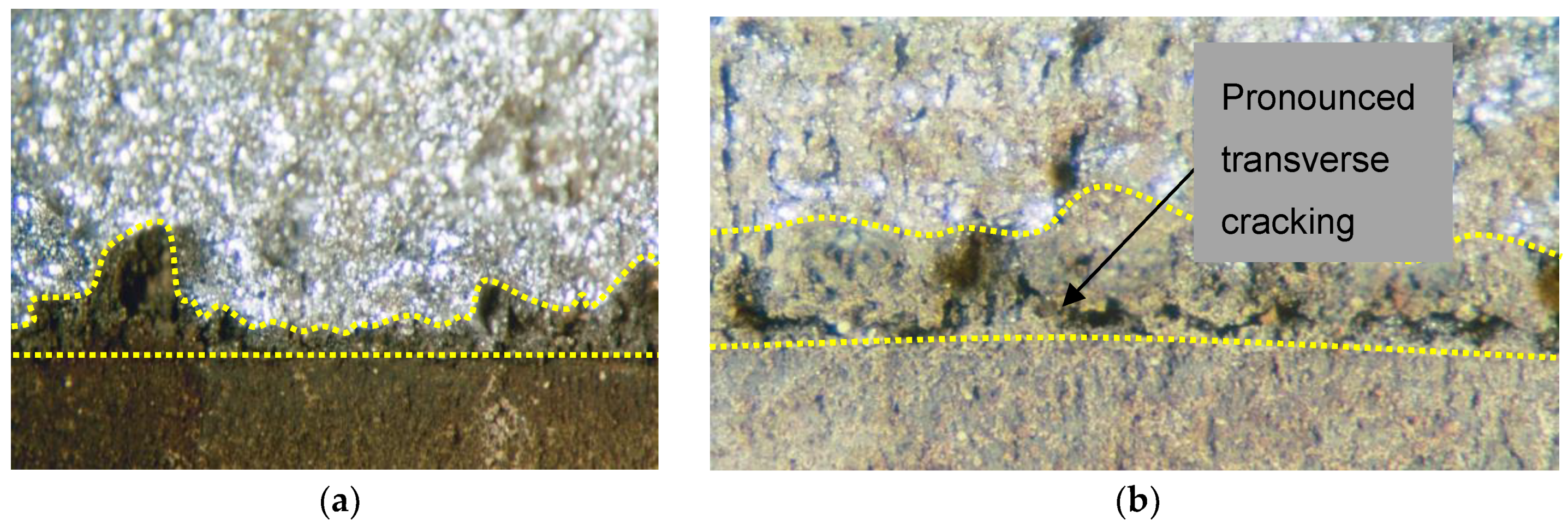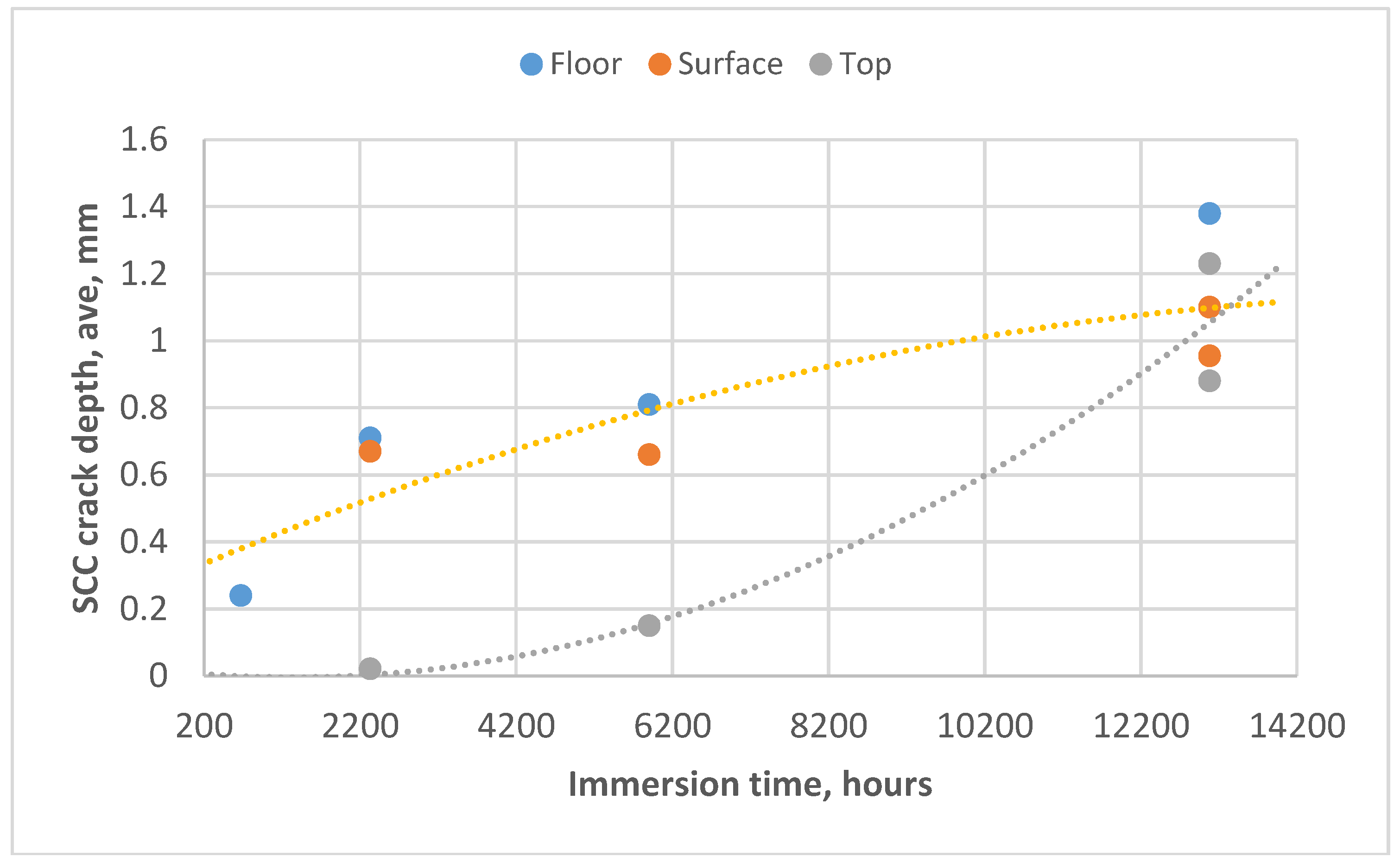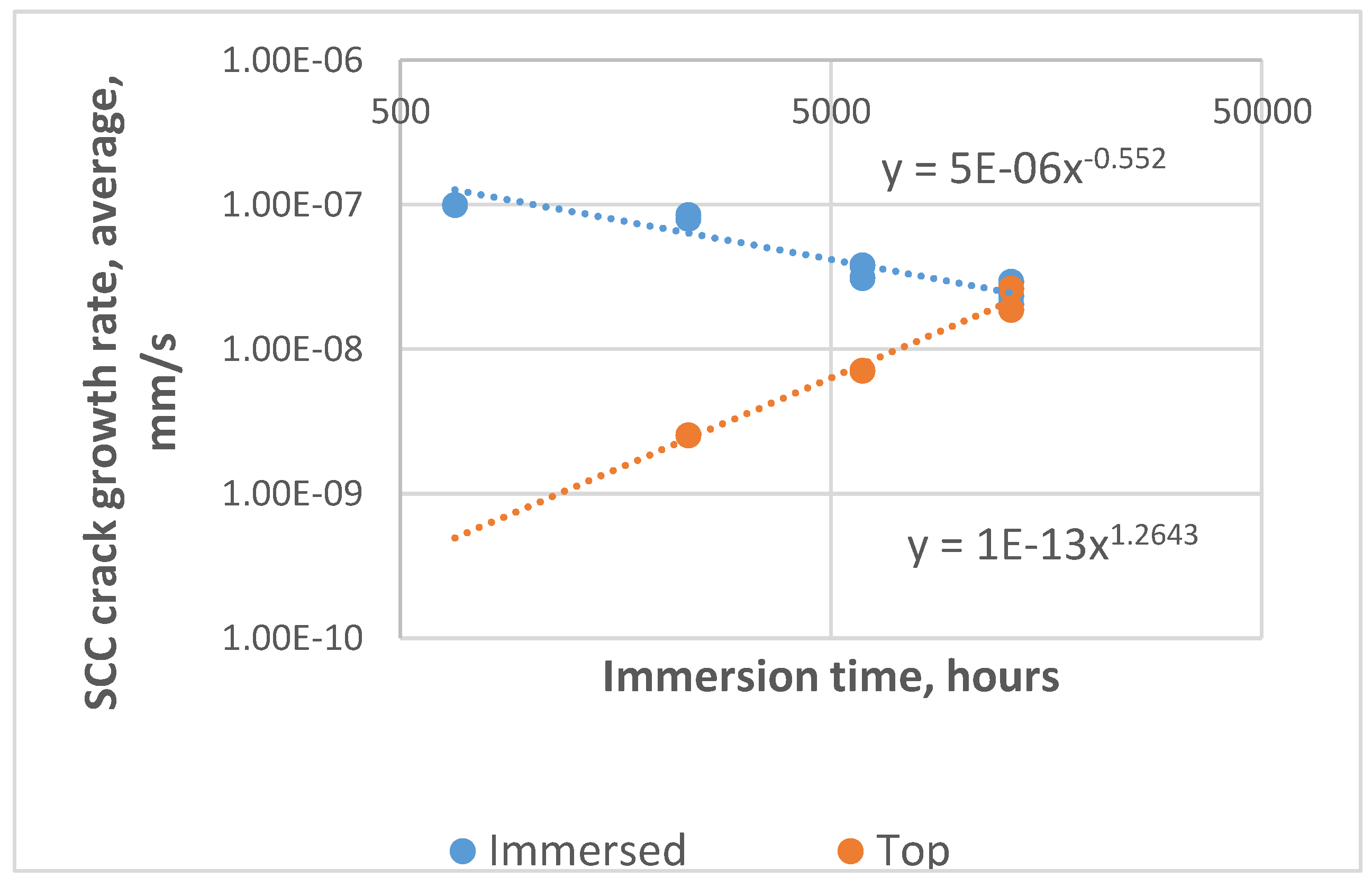Long-Term In-Situ Study of Mild Steel Stress Corrosion Cracking Kinetics in a Carbonate-Rich Solution †
Abstract
:1. Introduction
2. Literature
3. Specific Conditions
4. Experimental
4.1. Objectives
- The SCC crack growth kinetics from pre-existing cracks would be established. This approach would eliminate the “Stage 1” period in the SCC growth, where the required conditions for cracking are first established.
- SCC crack growth velocities in three distinct tank zones would be studied; close to the floor where permanent wetting would take place, at the “surface zone” where the steel is mostly covered by the tank content but where alternate wetting and drying will take place as tank levels vary (27% of tank height, immersed for ~80 per cent of the time), as well as in the “top zone” (50% of tank height) where the samples would be fully immersed for only ~40% of the time.
- Four successive exposure periods would be utilized, with the full study covering 13,080 h.
4.2. Technique
5. Experimental Results
5.1. First Exposure Period
5.2. Longer Exposure Periods
6. Discussion and Conclusions
Acknowledgments
Conflicts of Interest
References
- Kopyschinski, J.; Schildhauer, T.J.; Biollaz, S.M.A. Production of synthetic natural gas (SNG) from coal and dry biomass—A technology review from 1950 to 2009. Fuel 2010, 89, 1763–1783. [Google Scholar] [CrossRef]
- Parkins, R.N.; Usher, R. The stress-corrosion cracking of mild steel in coal gas liquors. J. Chem. Technol. Biotechnol. 1959, 9, 445–456. [Google Scholar]
- Parkins, R.N.; Belhimer, E.; Blanchard W.K., Jr. Stress Corrosion Cracking Characteristics of a Range of Pipeline Steels in Carbonate-Bicarbonate Solution. Corrosion 1993, 49, 951–966. [Google Scholar] [CrossRef]
- Parkins, R.N. Factors Influencing Stress Corrosion Crack Growth Kinetics. Corrosion 1987, 43, 130–139. [Google Scholar] [CrossRef]
- Parkins, R.N. Stress Corrosion Cracking. In Uhlig’s Corrosion Handbook, 3rd ed.; Uhlig, H.H., Ed.; John Wiley & Sons: Hoboken, NJ, USA, 2011; p. 174. [Google Scholar]
- Parkins, R.N.; Zhou, S. The Stress Corrosion Cracking of a C-Mn steel in CO2-HCO3−CO32− Solutions. 1: Stress Corrosion Data. Corros. Sci. 1997, 39, 159–173. [Google Scholar] [CrossRef]
- Sato, E.; Murata, T. Stress Corrosion Cracking of Steels in Coal Gas Liquid. Corrosion 1988, 44, 770–775. [Google Scholar] [CrossRef]
- Parkins, R.N. Mecanistic Aspects of Intergranular Stress Corrosion Cracking of Ferritic Steels. Corrosion 1996, 52, 363–374. [Google Scholar] [CrossRef]
- Parkins, R.N. Strain Rate Effects in Stress Corrosion Cracking. Corrosion 1990, 46, 178–189. [Google Scholar] [CrossRef]




| NH4+ | H2S | Cl− | SO42− | CO32− | pH | |
|---|---|---|---|---|---|---|
| Tank 1 | 1.52 | 0.35 | 0.98 | 5.4 | 1.82 | 8.93 |
| Ref. [7] | 3.05 | 1.45 | 2.2 | 0.075 | 2.85 | 9.5 |
| C | Mn | P | Si | Al | N |
|---|---|---|---|---|---|
| 0.21 | 1.10 | 0.015 | 0.007 | 0.028 | 90 |
| Immersion Period, Hours | Top Zone, % Immersion | Surface Zone, % Immersion | Top Zone, # Drying Incidents | Surface Zone, # Drying Incidents |
|---|---|---|---|---|
| 0–670 | 0 | 94 | 1 | 1 |
| 671–2328 | 0 | 98 | 1 | 1 |
| 2329–5940 | 34 | 66 | 4 | 4 |
| 5941–13,080 | 30 | 76 | 10 | 9 |
| 0–13,080 | 22.9 | 77 | 16 | 15 |
| Sample | Max. Crack Depth, mm | Average Crack Depth, mm | Ratio, amax/aave |
|---|---|---|---|
| Floor,TL | 0.82 | 0.24 | 3.42 |
| Floor, LT | 0.83 | 0.24 1 | 3.46 |
| Vapour, LT | 0.17 2 | - | - |
| Study | Sample Type | Rate, mm/s |
|---|---|---|
| Current | WOL | 2.43 1 × 10−8 |
| Sato [7] | U-bend | 2.22 × 10−9 |
| Parkins [4] | SSRT | 1.5 × 10−8 |
Publisher’s Note: MDPI stays neutral with regard to jurisdictional claims in published maps and institutional affiliations. |
© 2018 by the author. Licensee MDPI, Basel, Switzerland. This article is an open access article distributed under the terms and conditions of the Creative Commons Attribution (CC BY) license (https://creativecommons.org/licenses/by/4.0/).
Share and Cite
Mostert, R. Long-Term In-Situ Study of Mild Steel Stress Corrosion Cracking Kinetics in a Carbonate-Rich Solution. Proceedings 2018, 2, 377. https://doi.org/10.3390/ICEM18-05197
Mostert R. Long-Term In-Situ Study of Mild Steel Stress Corrosion Cracking Kinetics in a Carbonate-Rich Solution. Proceedings. 2018; 2(8):377. https://doi.org/10.3390/ICEM18-05197
Chicago/Turabian StyleMostert, Roelf. 2018. "Long-Term In-Situ Study of Mild Steel Stress Corrosion Cracking Kinetics in a Carbonate-Rich Solution" Proceedings 2, no. 8: 377. https://doi.org/10.3390/ICEM18-05197





